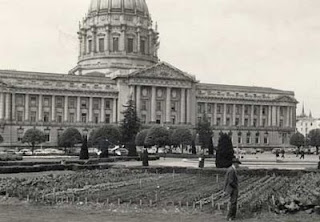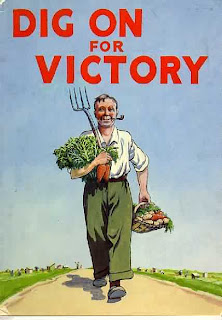 Photo courtesy the San Francisco History Center, San Francisco Public Library
Photo courtesy the San Francisco History Center, San Francisco Public LibrarySigh...yet another reason I often think I should be living up there instead of here since San Franciscans have been promoters and developers of sustainable food systems for so long. Now, they are creating a Victory Garden right in front of City Hall, calling the project The Slow Food Nation Victory Garden that will replace the lawn at City Hall.
They have the full support of Mayor Gavin Newsom and it is designed and built by the Garden for the Environment’s Victory Garden 08+ Program, CMG Landscape Architecture and City Slicker Farms, using seeds donated from Seeds of Change and numerous individuals from around the country.
Here's the scoop from a Press Release I received:
Beginning Tuesday, July 1, the lawn in front of San Francisco’s City Hall will undergo a transformation from grass carpet to edible garden, as dozens of Bay Area organizations join together to plant the Slow Food Nation Victory Garden. On Saturday, July 12, Mayor Gavin Newsom, Slow Food Nation founder Alice Waters and more than 100 volunteers will plant the first edible garden in the City’s Civic Center since 1943.
The Slow Food Nation Victory Garden is one more way to showcase the City’s tangible commitment to sustainability and, as in the past, confront some of the most challenging issues of our times,” said Mayor Gavin Newsom. “For many urban residents, access to healthy and nutritious food is as important now as it was during the Second World War.”
Slow Food Nation, the largest celebration of American food in history, takes place in San Francisco over Labor Day weekend (August 29 to September 1, 2008). The Slow Food Nation Victory Garden in the Civic Center will serve as a demonstration and education centerpiece leading up to and following the Labor Day weekend event, providing visitors the opportunity to learn about urban food production. Bounty from the garden will be donated to those with limited access to healthy, organic produce through a partnership with local food banks and meal programs.
It would be so awesome to have a project like this here, I can’t even imagine the chuckles and looks I would get if I even approached my local elected officials with such an idea. These are the kinds of projects that have inspired me to want to do something, like my Giving Gardeners idea, which I thought would be something that would be palatable to people here, but something like this could help so many more people and help us on our way to sustainability. Sigh…maybe one day.


 Erickson Farms of Fresno, has several different cherry varieties in the bing family.
Erickson Farms of Fresno, has several different cherry varieties in the bing family. These yummy apricots are from MB Farms (Mark Boujikian's farm).
These yummy apricots are from MB Farms (Mark Boujikian's farm).
